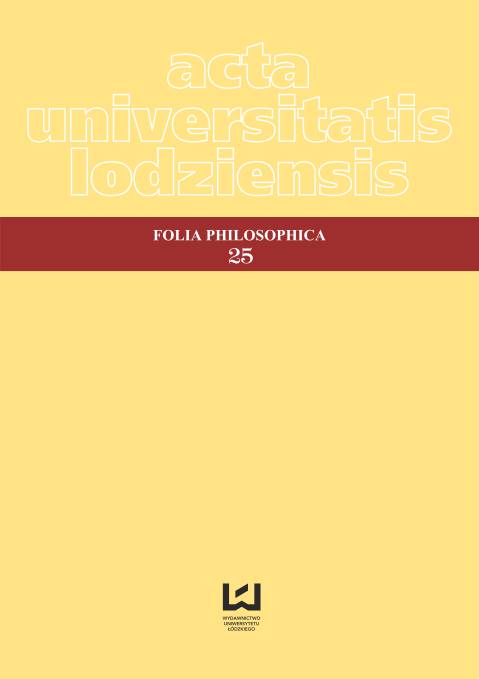Miejsce metafor w badaniach nad komunikacją
DOI:
https://doi.org/10.18778/0208-6107.25.08Abstrakt
The purpose of the present paper is to discuss several metaphorical conceptualizations of the phenomenon of communication from the perspective of cognitive linguistics. Apart from the purely linguistic and philosophical issues, the article touches upon the questions that concern the process of teaching and learning a foreign language (especially the so called "radically different one"). The thesis about our essentially metaphorical understanding of the phenomenon of communication, widely acknowledged in cognitive linguistics, is supported by empirical data drawn from Arabic and several Indo-European languages. Subsequently, the thesis is taken as a point of departure for discussing such issues as the problem of cross-linguistic variation of metaphors and their biological motivation. The paper consists of three sections: the first one examines the metaphor of communication as transfer, the second considers the metaphor of communication as enlightening, whereas the third presents some philosophical observations. The most important conclusion that is drawn here has it that the potential universality of various metaphorical conceptualizations is a very useful heuristic and didactic tool, for the existence of a common ground between languages that are genetically unrelated makes it possible not only to account for the ease with which certain elements of the target language can be translated into the source language, but also to hypothesize about the general mechanisms that are responsible for understanding and acquiring the (radically) different target language. Needless to say, such hypotheses are of paramount importance for the process of teaching and learning a foreign (especially radically different) language.Bibliografia
Abramowiczówna Z. 1965 (red.), Słownik grecko-polski, t. IV, Warszawa.
Google Scholar
Axelsen J. 1995, Dansk-engelsk Ordbog, Kopenhaga.
Google Scholar
Bielawski J. 1986 (tłum.), Koran, Warszawa.
Google Scholar
Chodera J., Kubica S. 1966, Podręczny słownik niemiecko-polski, Warszawa.
Google Scholar
Damasio A.R. 2002, Błąd Kartezjusza. Emocje, rozum i ludzki mózg (tłum. M. Karpiński), Poznań.
Google Scholar
Danecki J. 2001, Gramatyka języka arabskiego, t. I, Warszawa.
Google Scholar
Danecki J., Kozłowska J. 2007, Słownik arabsko-polski, Warszawa.
Google Scholar
Domaradzki M. 2011, The Self in Arabic and the Relativism-Universalism Controversy, „Cognitive Linguistics” 22, s. 535–567.
Google Scholar
DOI: https://doi.org/10.1515/cogl.2011.021
Fakhry M. 2002, An Interpretation of the Qur’an. English Translation of the Meanings.
Google Scholar
A Bilingual Edition, New York.
Google Scholar
Hermann, C.F. 1911, Platonis Dialogi secundum Trasylli tetralogias dispositi, t. IV, Lipsk.
Google Scholar
Jäkel O. 2003, Metafory w abstrakcyjnych domenach dyskursu. Kognitywno-lingwistyczna analiza metaforycznych modeli aktywności umysłowej, gospodarki i nauki (tłum. M. Banaś i B. Drąg), Kraków.
Google Scholar
Knudsen S. 2003, Scientific Metaphors Going Public, „Journal of Pragmatics”, 35, s. 1247–1263.
Google Scholar
DOI: https://doi.org/10.1016/S0378-2166(02)00187-X
Kulczycki E. 2012, Teoretyzowanie komunikacji, Poznań.
Google Scholar
Kupisz K., Kielski B. 1971, Podręczny słownik francusko-polski, Warszawa.
Google Scholar
Lakoff G. i M. Johnson 1999, Philosophy in the Flesh. The Embodied Mind and Its Challenge to Western Thought, New York.
Google Scholar
Lakoff G. i M. Johnson 2010, Metafory w naszym życiu (tłum. T.P. Krzeszowski), Warszawa.
Google Scholar
Nestle E. 1923 (red.), Novum Testamentum Graece, Stuttgart.
Google Scholar
Ortony A. 1993, (red.), Metaphor and Thought, Cambridge.
Google Scholar
Peter M. i M. Wolniewicz 2004 (red.) Pismo Święte. Stary i Nowy Testament, Poznań.
Google Scholar
Platon 1999, Państwo. Prawa (tłum. W. Witwicki), Kęty.
Google Scholar
Plezia M. 1998a (red.), Słownik łacińsko-polski, t. II, Warszawa.
Google Scholar
Plezia M. 1998b (red.), Słownik łacińsko-polski, t. III, Warszawa.
Google Scholar
Reddy M.J. 1993, The Conduit Metaphor: A Case of Frame Conflict in Our Language About
Google Scholar
DOI: https://doi.org/10.1017/CBO9781139173865.012
Language [w:] A. Ortony (red.), Metaphor and Thought, Cambridge 1993, s. 164–201.
Google Scholar
DOI: https://doi.org/10.1017/CBO9781139173865
Ryding K.C. 2005, A Reference Grammar of Modern Standard Arabic, Cambridge.
Google Scholar
DOI: https://doi.org/10.1017/CBO9780511486975
Stanisławski J. 1966, Wielki słownik angielsko-polski, Warszawa.
Google Scholar
Szymczak M. 1989 (red.), Słownik języka polskiego, t. III, Warszawa.
Google Scholar
Wendland M. 2011, Konstruktywizm komunikacyjny, Poznań.
Google Scholar
Yu N. 2003, Chinese Metaphors of Thinking, „Cognitive Linguistics”, 14, s. 141–165.
Google Scholar
DOI: https://doi.org/10.1515/cogl.2003.006
Pobrania
Opublikowane
Jak cytować
Numer
Dział
Licencja

Praca jest udostępniana na licencji Creative Commons Attribution-NonCommercial-NoDerivatives 3.0 Unported License.












